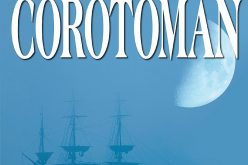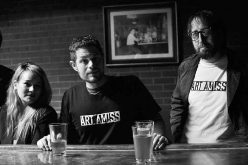Entering the gallery space for the new temporary exhibition at Crystal Bridges Museum of American Art in Bentonville, the alluring gleam of two silver figures is the first sight to greet visitors. John Prip’s “Silver Coffeepot” and Myra Mimlitcsh-Gray’s “Melting Teapot” offer an immediate opportunity to compare and contrast in a conversation that lays the foundation for the rest of “Crafting America.”
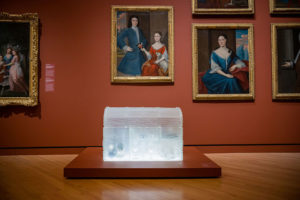
Buzz Trevathan of Bella Vista looks at an art installment called “Circle Dance – A Tribute to John Scott,” Friday, February 5, 2021 at Crystal Bridges Museum of American Art in Bentonville. A new exhibit, titled “Crafting America,” opens February 6. The exhibition features 120 works in media, including ceramics, fiber, wood, metal and glass, all celebrating the skill and individuality of craft with the context of American art. Check out nwaonline.com/210206Daily/ for today’s photo gallery. (The Free Weekly/Charlie Kaijo)
The two works — Prip’s Danish-inspired modern coffee pot and Mimlitcsh-Gray’s trompe l’oeil of a solid melting to a liquid — were each created by a master metalsmith, of the same material, using nearly the same exact technique. The pairing, and all those that follow in the exhibition, illuminate key concepts in the genre of craft, which is explored for the first time at Crystal Bridges in the new exhibit.
“One of the goals that we had for the exhibition was to tell the story of craft and American art, and to assert its place as an integral component of the unfolding story of American art,” offers co-curator Jen Padgett. “Crafting America” is the first temporary exhibition of 2021 at the museum after its debut, originally scheduled for last year, had to be postponed due to covid-19.
“It fits so well with our mission to expand those stories in our galleries, and this show, in many ways, acts as a kind of catalyst for what will be a really deep and rich and complex further engagement with artists who work in a variety of craft practices,” Padgett says.
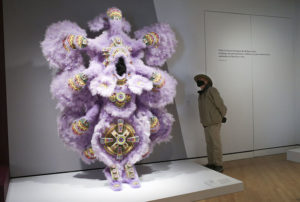
“Circle Dance — A Tribute to John Scott” by Darryl Montana is one of several lavish costumes on display toward the end of the exhibition, Adamson says. Montana is a master Mardi Gras suitmaker and Chief of the Yellow Pocahontas “Hunters” Black “masking” Indian Tribe in New Orleans.
“There’s a very interesting conversation to be had here about African-American communities, their creativity and dialogue with Native American imagery,” Adamson muses. “And, in fact, we’ve paired this work with one by Nick Cave, who will be well known to [visitors] as an artist in the Crystal Bridges collection, and also Jamie Okuma, who is a Native fashion designer.”
(The Free Weekly/Charlie Kaijo)
Each of these materials has its own unique history and organizers knew viewers would come to the exhibition with myriad perceptions of the field. So the curators decided to take a straightforward interpretation of craft: skilled making at human scale.
It’s a form that, regardless of medium, requires intensive training and technical skills that are learned, Padgett clarifies. This framework distinguishes the medium from handmade pieces, as well as from machine manufacturing, adds Glenn Adamson, guest curator and scholar of craft, design history and contemporary art.
Historically, Padgett explains, craft has been a form that was widely accessible to women, people of color, immigrants and indigenous peoples, especially during periods when the world of fine art was more difficult to enter.
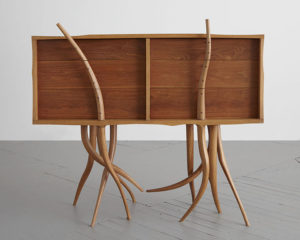
Wendell Castle, who is “undoubtedly the most significant furniture artist of the post-war period,” says co-curator Glenn Adamson, is seen in the “Liberty” section of the exhibition with his innovative “Chest of Drawers” piece.
“It’s extremely clever in its composition; you can see that the legs, which have this kind of tendril or root-like shape, then grow up into the front of the piece,” Adamson details. “And you can see that they’ve been turned into the handles of the drawers so each of the sections of those carved elements can be used as a drawer pull.”
(R & Company/Copyright Wendell Castle Estate)
(Courtesy Photo/Joe Kramm)
“It became this wellspring of an outlet for creative activity,” she says. For instance, she notes, textile production has a deep history as an arena in which women could find careers and break new ground. “So when you start to focus on craft as an American art, it allows you to tell a much more diverse story, and especially in seeing how contemporary artists today use craft media or use craft technique to explore those histories.”
Along with the media and the techniques, contemporary artists are using the visual language of the objects, processes or functions their art may be referencing, Padgett notes. An excellent example of this, she says, is Sabrina Gschwandtner’s “Hands at Work Film.” Using 16mm film rather than textile woven into a quilt-like pattern, Gschwandtner references the tradition of the form, bringing about a new layer of meaning. The material transforms the piece to a work that speaks to historic and contemporary practices alike.
“We do have things that are extremely technically accomplished and show you the kind of rigors that are required to make something,” Padgett says, “and then some things that seemingly are relatively straightforward, but they require just as much knowledge of the material and just as much expertise for the artist to be able to use them in ways that are unexpected. So sometimes, even things that look simple are quite complex.”
“Crafting America” is organized into four thematic sections: “Introduction/What is Craft”; “Life”; “Liberty”; and “The Pursuit of Happiness.” A commonality in materials draws connections between object pairings throughout each section that speak to different perspectives on American identity, further alluding to those ideals set forth in the Declaration of Independence.
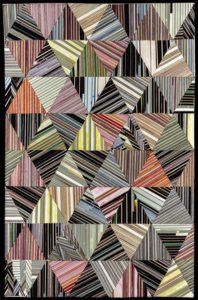
“In this section, we also bring attention to the lives of makers because the time that artists spend honing their craft and making an individual object create a tie between the biography of the artist and the work that they’re making,” Jen Padgett says of the “Life” section, where Sabrina Gschwandtner’s “Hands at Work Film” is included. “And, even more deeply, the sense of connection between craft and the human element — that humanistic quality when you’re in the presence of an object that speaks so strongly to that lasting relationship between artists and material — is something that’s really present throughout the show.”
(Courtesy Image/Crystal Bridges Museum, Photo by Joshua White Photography)
“From the apparent humility of the ‘Life’ section — although, of course, a lot of those objects have a kind of quiet majesty to them — we come into the much more heroic and gesturally expressive works of the post-war era,” Adamson summarizes.
The idea of “Liberty,” he explains, is interpreted here as a kind of individual artistic freedom that’s powered by craft before, in “the Pursuit of Happiness,” a grand finale of imaginative, delightful and fantastical works is presented to the viewer.
This final section comprises some “extremely extravagant and visually powerful works,” he concludes. “These artists are taking techniques like basketry, various fiber techniques, pottery and taking those same skills and same materials and processes and elevating them to these expressions of absolutely monumental ambition.”
The Year Ahead
Among Northwest Arkansas arts organizations, Crystal Bridges is one institution that was able to reopen sooner than many after establishing new safety guidelines in the wake of last year’s pandemic.
With the whole of the art world in flux at every level — down to art transportation affecting exhibition schedules — CBM staff were thrilled that they were able to extend the two temporary exhibitions that had been on display prior to the closure, Public Relations Director Beth Bobbitt told What’s Up! at the time.
“Hank Willis Thomas: All Things Being Equal…” and “State of the Art 2020” were both extended to allow more visitors to view the shows’ meaningful works. “Ansel Adams: In Our Time” was pushed from a May debut to September. And the focus exhibition “Companion Species” moved to a November opening, to now be displayed through the end of May.
“As art organizations focused on access, we strive to provide offerings in a variety of ways,” Bobbitt says of the adjustments wrought by covid and turning focus to the new year.
“In addition to our on-site experiences and virtual programs, we will continue to create more online content and enhance digital resources. Content includes 360 tours, virtual reality experiences, virtual weekly music playlists, audio guides and video tours through the galleries and grounds, #CBfromHome activities for families, free (virtual) school field trips and other educational tools.”

Sonya Clark’s “Beaded Prayers Project” is constructed from individual pouches and beadwork contributed by more than 5,000 individuals over the course of the past two decades.
“You get that sense of the personal connection between this work and the maker who created it,” co-curator Jen Padgett says of the piece. “And then as they come together, there’s this really beautiful sense of the collaborative whole, the idea that this community presentation becomes something so much larger than any individual work.”
(The Free Weekly/Charlie Kaijo)
At the same time Crystal Bridges staff were looking to engage arts lovers from home, the institution’s outreach efforts in response to addressing the covid crisis in the community were also a priority. Those efforts ended up surpassing what even the museum’s team had planned for, Bobbitt shares.
“With the support of local partner organizations, we mobilized staff to meet the needs of those most vulnerable in our community, distributing thousands of meals, house-cleaning supplies and personal-care kits,” she demonstrates. “We were able to expand access to art with the opening of the Momentary, develop more online programs and resources, and share the power of art to promote social change and champion diversity.
“While we’re always evaluating how to move forward into the unknown,” Bobbitt says, again turning to the future, “Crystal Bridges and the Momentary will remain committed to being an anti-racist organization, fostering social connections through arts experiences and leaning in to the power of art to build community. We will continue to enhance online experiences but treasure the in-person visit, creating an environment where synergy can be built and transformative moments are possible.”
To those ends, Crystal Bridges staff have adjusted strategic goals to meet covid-related challenges, racial inequities and to embrace their role as a community-centered institution. As part of that, Bobbitt shares, their teams want to utilize the museum as a living classroom for curiosity and joyful learning, establish an environment of inclusion and belonging founded on anti-racist principles, and provide even more opportunities for visitors to engage in art, nature and architecture.
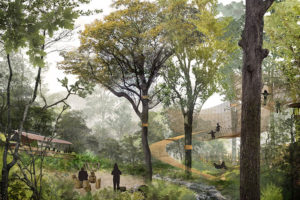
A concept rendering of Convergence presents ideas for the four-acre outdoor playscape collaboration between Crystal Bridges Museum of American Art and the Scott Family Amazeum.
The first of CBM’s temporary exhibitions for 2021 opened Feb. 6, and two more major exhibitions will debut later in the year. Though exhibitions are still scheduled years in advance, there may be more frequent check-ins and adjustments as the world and Northwest Arkansas continue to respond to the pandemic. Mostly virtual programming, though, has allowed for greater flexibility to schedule on a shorter timeline (one to two months in advance), Bobbitt reveals.
As for friends, family and fans of the museum, Bobbitt says there’s a few ways arts lovers can continue to support Crystal Bridges as the museum closes out its first decade:
“Learn alongside us and support projects, artists and organizations that take conversations about diversity, equity and inclusion to the next phase of work.
“We’re excited about more in-depth partnerships and collaborations with communities that will expand the voices and perspectives in the museum,” she continues. “Crystal Bridges and the Momentary can be places of respite and inspiration as well. The power of art, architecture and nature is here for our community to access and enjoy, and we strive to provide that for everyone.”
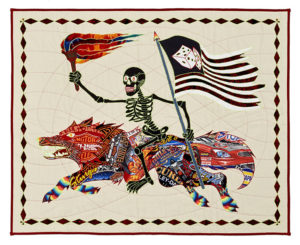
Ben Venom’s handmade quilt “I Am the Night Rider” is on display as part of the “Crafting America” temporary exhibition, which opened at Crystal Bridges Museum in Bentonville Feb. 6. The exhibit is on display through May 31.
(Courtesy Photo/Gregg Museum of Art & Design)
FAQ
‘Crafting America’
WHEN — On display through May 31
WHERE — Crystal Bridges Museum of American Art in Bentonville
COST — $12; free for members, veterans, SNAP participants and those younger than 18
INFO — 418-5700, crystalbridges.org


